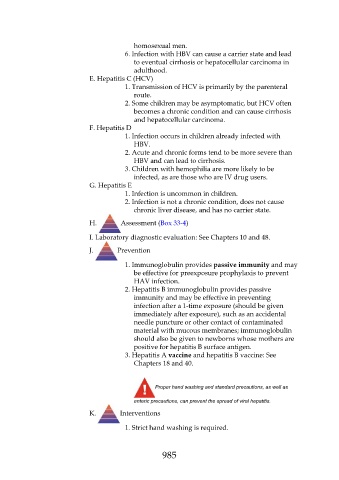Page 985 - Saunders Comprehensive Review For NCLEX-RN
P. 985
homosexual men.
6. Infection with HBV can cause a carrier state and lead
to eventual cirrhosis or hepatocellular carcinoma in
adulthood.
E. Hepatitis C (HCV)
1. Transmission of HCV is primarily by the parenteral
route.
2. Some children may be asymptomatic, but HCV often
becomes a chronic condition and can cause cirrhosis
and hepatocellular carcinoma.
F. Hepatitis D
1. Infection occurs in children already infected with
HBV.
2. Acute and chronic forms tend to be more severe than
HBV and can lead to cirrhosis.
3. Children with hemophilia are more likely to be
infected, as are those who are IV drug users.
G. Hepatitis E
1. Infection is uncommon in children.
2. Infection is not a chronic condition, does not cause
chronic liver disease, and has no carrier state.
H. Assessment (Box 33-4)
I. Laboratory diagnostic evaluation: See Chapters 10 and 48.
J. Prevention
1. Immunoglobulin provides passive immunity and may
be effective for preexposure prophylaxis to prevent
HAV infection.
2. Hepatitis B immunoglobulin provides passive
immunity and may be effective in preventing
infection after a 1-time exposure (should be given
immediately after exposure), such as an accidental
needle puncture or other contact of contaminated
material with mucous membranes; immunoglobulin
should also be given to newborns whose mothers are
positive for hepatitis B surface antigen.
3. Hepatitis A vaccine and hepatitis B vaccine: See
Chapters 18 and 40.
Proper hand washing and standard precautions, as well as
enteric precautions, can prevent the spread of viral hepatitis.
K. Interventions
1. Strict hand washing is required.
985

